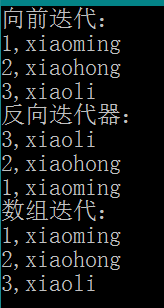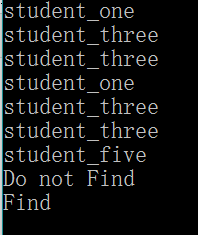C++ STL 中 map 容器
C++ STL 中 map 容器
Map是STL的一个关联容器,它提供一对一(其中第一个可以称为关键字,每个关键字只能在map中出现一次,第二个可能称为该关键字的值)的数据 处理能力,由于这个特性,它完成有可能在我们处理一对一数据的时候,在编程上提供快速通道。这里说下map内部数据的组织,map内部自建一颗红黑树(一 种非严格意义上的平衡二叉树),这颗树具有对数据自动排序的功能,所以在map内部所有的数据都是有序的,后边我们会见识到有序的好处。
1、map简介
map是一类关联式容器。它的特点是增加和删除节点对迭代器的影响很小,除了那个操作节点,对其他的节点都没有什么影响。
对于迭代器来说,可以修改实值,而不能修改key。
2、map的功能
自动建立Key - value的对应。key 和 value可以是任意你需要的类型。
根据key值快速查找记录,查找的复杂度基本是Log(N),如果有1000个记录,最多查找10次,1,000,000个记录,最多查找20次。
快速插入Key -Value 记录。
快速删除记录
根据Key 修改value记录。
遍历所有记录。
3、使用map
使用map得包含map类所在的头文件
#include <map> //注意,STL头文件没有扩展名.h
map对象是模板类,需要关键字和存储对象两个模板参数:
std:map<int,string> personnel;
这样就定义了一个用int作为索引,并拥有相关联的指向string的指针.
为了使用方便,可以对模板类进行一下类型定义,
typedef map<int,CString> UDT_MAP_INT_CSTRING; UDT_MAP_INT_CSTRING enumMap;
4、map的构造函数
map共提供了6个构造函数,这块涉及到内存分配器这些东西,略过不表,在下面我们将接触到一些map的构造方法,这里要说下的就是,我们通常用如下方法构造一个map:
map<int, string> mapStudent;
5、数据的插入
在构造map容器后,我们就可以往里面插入数据了。这里讲三种插入数据的方法:
第一种:用insert函数插入pair数据(C++学习之Pair),下面举例说明(以下代码虽然是随手写的,应该可以在VC和GCC下编译通过,大家可以运行下看什么效果,在VC下请加入这条语句,屏蔽4786警告 #pragma warning (disable:4786) )
//数据的插入--第一种:用insert函数插入pair数据
#include <map>
#include <string>
#include <iostream>
using namespace std;
int main()
{
map<int, string> mapStudent;
mapStudent.insert(pair<int, string>(, "student_one"));
mapStudent.insert(pair<int, string>(, "student_two"));
mapStudent.insert(pair<int, string>(, "student_three"));
map<int, string>::iterator iter;
for(iter = mapStudent.begin(); iter != mapStudent.end(); iter++)
cout<<iter->first<<' '<<iter->second<<endl;
return ;
}

第二种:用insert函数插入value_type数据
每个STL中的类都有value_type这种东西,通俗的说value_type 就是stl容器盛装的数据的数据类型,例如:
vector<int> vec; vector<int>::value_type x;
上述两句代码,第一句是声明一个盛装数据类型是int的数据的vector,第二句是使用vector<int>::value_type定义一个变量x,这个变量x实际上是int类型的,因为vector<int>::value_type中声明的为int型。
相应的,假设有:
vector<C> vec; //假设C是自定义类型 vector<C>::value_type x;
那么第二句定义的变量x的数据类型是C。
每个STL容器类(感觉应该是迭代器类更加准确),都有一句相同的代码:
typede T value_type;
其中T则是类模板中使用的参数 :
template <class T>
以STL的list容器为例,那么它的类定义就应该有下面的语句:
template<class T>
class list{
publict:
typedef T value_type;
//……
};
下面举例说明:
//第二种:用insert函数插入value_type数据,下面举例说明
#include <map>
#include <string>
#include <iostream>
using namespace std;
int main()
{
map<int, string> mapStudent;
mapStudent.insert(map<int, string>::value_type (, "student_one"));
mapStudent.insert(map<int, string>::value_type (, "student_two"));
mapStudent.insert(map<int, string>::value_type (, "student_three"));
map<int, string>::iterator iter;
for(iter = mapStudent.begin(); iter != mapStudent.end(); iter++)
cout<<iter->first<<' '<<iter->second<<endl;
return ;
}
第三种:用数组方式插入数据,下面举例说明
//第三种:用数组方式插入数据,下面举例说明
#include <map>
#include <string>
#include <iostream>
using namespace std;
int main()
{
map<int, string> mapStudent;
mapStudent[] = "student_one";
mapStudent[] = "student_two";
mapStudent[] = "student_three";
map<int, string>::iterator iter;
for(iter = mapStudent.begin(); iter != mapStudent.end(); iter++)
cout<<iter->first<<' '<<iter->second<<endl;
}
以上三种用法,虽然都可以实现数据的插入,但是它们是有区别的,当然了第一种和第二种在效果上是完成一样的,用insert函数插入数据,在数据的 插入上涉及到集合的唯一性这个概念,即当map中有这个关键字时,insert操作是插入数据不了的,但是用数组方式就不同了,它可以覆盖以前该关键字对 应的值,用程序说明
mapStudent.insert(map<int, string>::value_type (, "student_one")); mapStudent.insert(map<int, string>::value_type (, "student_two"));
上面这两条语句执行后,map中1这个关键字对应的值是“student_one”,第二条语句并没有生效,那么这就涉及到我们怎么知道insert语句是否插入成功的问题了,可以用pair来获得是否插入成功,程序如下
pair<map<int, string>::iterator, bool> Insert_Pair; Insert_Pair = mapStudent.insert(map<int, string>::value_type (, "student_one"));
我们通过pair的第二个变量来知道是否插入成功,它的第一个变量返回的是一个map的迭代器,如果插入成功的话Insert_Pair.second应该是true的,否则为false。
6、 map的大小
在往map里面插入了数据,我们怎么知道当前已经插入了多少数据呢,可以用size函数,用法如下:
Int nSize = mapStudent.size();
7、 数据的遍历
这里也提供三种方法,对map进行遍历
第一种:应用前向迭代器
第二种:应用反相迭代器
第三种,用数组的形式
#include<map>
#include<iostream>
#include<string>
using namespace std;
int main()
{
map<int,string> myString;
myString.insert(pair<int,string>(,"xiaoming"));
myString.insert(map<int,string>::value_type (,"xiaohong"));
myString[] = "xiaoli"; cout<<"向前迭代:"<<endl;
map<int,string>::iterator iter;//向前迭代
for(iter = myString.begin();iter != myString.end();iter++)
{
cout<<iter->first<<","<<iter->second<<endl;
} cout<<"反向迭代器:"<<endl;
map<int,string>::reverse_iterator iter2;
for(iter2 = myString.rbegin();iter2 != myString.rend();iter2++)
cout<<iter2->first<<","<<iter2->second<<endl; cout<<"数组迭代:"<<endl;
int Length = myString.size();
for(int i = ;i <= Length;i++)
cout<<i<<","<<myString[i]<<endl;
return ;
}
运行结果:

8、查找并获取map中的元素(包括判定这个关键字是否在map中出现)
在这里我们将体会,map在数据插入时保证有序的好处。
要判定一个数据(关键字)是否在map中出现的方法比较多,这里标题虽然是数据的查找,在这里将穿插着大量的map基本用法。
这里给出三种数据查找方法
第一种:用count函数来判定关键字是否出现,其缺点是无法定位数据出现位置,由于map的特性,一对一的映射关系,就决定了count函数的返回值只有两个,要么是0,要么是1,出现的情况,当然是返回1了
第二种:用find函数来定位数据出现位置,它返回的一个迭代器,当数据出现时,它返回数据所在位置的迭代器,如果map中没有要查找的数据,它返回的迭代器等于end函数返回的迭代器。
查找map中是否包含某个关键字条目用find()方法,传入的参数是要查找的key,在这里需要提到的是begin()和end()两个成员,
分别代表map对象中第一个条目和最后一个条目,这两个数据的类型是iterator.
#include <map>
#include <string>
#include <iostream>
using namespace std;
int main()
{
map<int, string> mapStudent;
mapStudent.insert(pair<int, string>(, "student_one"));
mapStudent.insert(pair<int, string>(, "student_two"));
mapStudent.insert(pair<int, string>(, "student_three"));
map<int, string>::iterator iter;
iter = mapStudent.find();
if(iter != mapStudent.end())
cout<<"Find, the value is "<<iter->second<<endl;
else
cout<<"Do not Find"<<endl;
return ;
}
通过map对象的方法获取的iterator数据类型是一个std::pair对象,包括两个数据 iterator->first和 iterator->second分别代表关键字和存储的数据。
第三种:Equal_range
ForwardIter lower_bound(ForwardIter first, ForwardIter last,const _Tp& val)算法返回一个非递减序列[first, last)中的第一个大于等于值val的位置。这个函数用来返回要查找关键字的下界(是一个迭代器)
ForwardIter upper_bound(ForwardIter first, ForwardIter last, const _Tp& val)算法返回一个非递减序列[first, last)中第一个大于val的位置。这个函数用来返回要查找关键字的上界(是一个迭代器)
lower_bound和upper_bound如下图所示:

例如:map中已经插入了1,2,3,4的话,如果lower_bound(2)的话,返回的2,而upper-bound(2)的话,返回的就是3
Equal_range函数返回一个pair,pair里面第一个变量是Lower_bound返回的迭代器,pair里面第二个变量是Upper_bound返回的迭代器,如果这两个迭代器相等的话,则说明map中不出现这个关键字。
#include <map>
#include <string>
#include <iostream>
using namespace std;
int main()
{
map<int, string> mapStudent;
mapStudent[] = "student_one";
mapStudent[] = "student_three";
mapStudent[] = "student_five";
map<int, string>::iterator iter;
iter = mapStudent.lower_bound();
//返回的是下界1的迭代器
cout<<iter->second<<endl;
iter = mapStudent.lower_bound();
//返回的是下界2的迭代器
cout<<iter->second<<endl;
iter = mapStudent.lower_bound();
//返回的是下界3的迭代器
cout<<iter->second<<endl; iter = mapStudent.upper_bound();
//返回的是上界0的迭代器
cout<<iter->second<<endl;
iter = mapStudent.upper_bound();
//返回的是上界1的迭代器
cout<<iter->second<<endl;
iter = mapStudent.upper_bound();
//返回的是上界2的迭代器
cout<<iter->second<<endl;
iter = mapStudent.upper_bound();
//返回的是上界3的迭代器
cout<<iter->second<<endl; pair<map<int, string>::iterator, map<int, string>::iterator> mappair;
mappair = mapStudent.equal_range();
if(mappair.first == mappair.second)
cout<<"Do not Find"<<endl;
else
cout<<"Find"<<endl;
mappair = mapStudent.equal_range();
if(mappair.first == mappair.second)
cout<<"Do not Find"<<endl;
else
cout<<"Find"<<endl;
return ;
}
运行结果:

9、从map中删除元素
移除某个map中某个条目用erase()
该成员方法的定义如下:
iterator erase(iterator it);//通过一个条目对象删除 iterator erase(iterator first,iterator last);//删除一个范围 size_type erase(const Key&key);//通过关键字删除 clear()就相当于enumMap.erase(enumMap.begin(),enumMap.end());
这里要用到erase函数,它有三个重载了的函数,下面在例子中详细说明它们的用法
#include <map>
#include <string>
#include <iostream>
using namespace std;
int main()
{
map<int, string> mapStudent;
mapStudent.insert(pair<int, string>(, "student_one"));
mapStudent.insert(pair<int, string>(, "student_two"));
mapStudent.insert(pair<int, string>(, "student_three"));
//如果你要演示输出效果,请选择以下的一种,你看到的效果会比较好
//如果要删除1,用迭代器删除
map<int, string>::iterator iter;
iter = mapStudent.find();
mapStudent.erase(iter); //如果要删除1,用关键字删除
int n = mapStudent.erase();//如果删除了会返回1,否则返回0 //用迭代器,成片的删除
//一下代码把整个map清空
mapStudent.erase( mapStudent.begin(), mapStudent.end() );
//成片删除要注意的是,也是STL的特性,删除区间是一个前闭后开的集合
//自个加上遍历代码,打印输出吧
}
10、map中的swap用法
map中的swap不是一个容器中的元素交换,而是两个容器所有元素的交换。
11、 排序 map中的sort问题
map中的元素是自动按Key升序排序,所以不能对map用sort函数;
这里要讲的是一点比较高深的用法了,排序问题,STL中默认是采用小于号来排序的,以上代码在排序上是不存在任何问题的,因为上面的关键字是int 型,它本身支持小于号运算,在一些特殊情况,比如关键字是一个结构体,涉及到排序就会出现问题,因为它没有小于号操作,insert等函数在编译的时候过 不去,下面给出两个方法解决这个问题。
第一种:小于号重载
#include <iostream>
#include <string>
#include <map>
using namespace std;
typedef struct tagStudentinfo
{
int niD;
string strName;
bool operator < (tagStudentinfo const& _A) const
{ //这个函数指定排序策略,按niD排序,如果niD相等的话,按strName排序
if(niD < _A.niD) return true;
if(niD == _A.niD)
return strName.compare(_A.strName) < ;
return false;
}
}Studentinfo, *PStudentinfo; //学生信息
int main()
{
int nSize; //用学生信息映射分数
map<Studentinfo, int>mapStudent;
map<Studentinfo, int>::iterator iter;
Studentinfo studentinfo;
studentinfo.niD = ;
studentinfo.strName = "student_one";
mapStudent.insert(pair<Studentinfo, int>(studentinfo, ));
studentinfo.niD = ;
studentinfo.strName = "student_two";
mapStudent.insert(pair<Studentinfo, int>(studentinfo, ));
for (iter=mapStudent.begin(); iter!=mapStudent.end(); iter++)
cout<<iter->first.niD<<' '<<iter->first.strName<<' '<<iter->second<<endl;
return ;
}
第二种:仿函数的应用,这个时候结构体中没有直接的小于号重载
//第二种:仿函数的应用,这个时候结构体中没有直接的小于号重载,程序说明
#include <iostream>
#include <map>
#include <string>
using namespace std;
typedef struct tagStudentinfo
{
int niD;
string strName;
}Studentinfo, *PStudentinfo; //学生信息
class sort
{
public:
bool operator() (Studentinfo const &_A, Studentinfo const &_B) const
{
if(_A.niD < _B.niD)
return true;
if(_A.niD == _B.niD)
return _A.strName.compare(_B.strName) < ;
return false;
}
};
int main()
{ //用学生信息映射分数
map<Studentinfo, int, sort>mapStudent;
map<Studentinfo, int>::iterator iter;
Studentinfo studentinfo;
studentinfo.niD = ;
studentinfo.strName = "student_one";
mapStudent.insert(pair<Studentinfo, int>(studentinfo, ));
studentinfo.niD = ;
studentinfo.strName = "student_two";
mapStudent.insert(pair<Studentinfo, int>(studentinfo, ));
for (iter=mapStudent.begin(); iter!=mapStudent.end(); iter++)
cout<<iter->first.niD<<' '<<iter->first.strName<<' '<<iter->second<<endl;
return ;
}
由于STL是一个统一的整体,map的很多用法都和STL中其它的东西结合在一起,比如在排序上,这里默认用的是小于号,即less<>,如果要从大到小排序呢,这里涉及到的东西很多,在此无法一一加以说明。
还要说明的是,map中由于它内部有序,由红黑树保证,因此很多函数执行的时间复杂度都是log2N的,如果用map函数可以实现的功能,而STL Algorithm也可以完成该功能,建议用map自带函数,效率高一些。
下面说下,map在空间上的特性,否则,估计你用起来会有时候表现的比较郁闷,由于map的每个数据对应红黑树上的一个节点,这个节点在不保存你的 数据时,是占用16个字节的,一个父节点指针,左右孩子指针,还有一个枚举值(标示红黑的,相当于平衡二叉树中的平衡因子),我想大家应该知道,这些地方 很费内存了吧,不说了……
12、 map的基本操作函数:
C++ maps是一种关联式容器,包含“关键字/值”对
begin() 返回指向map头部的迭代器
clear() 删除所有元素
count() 返回指定元素出现的次数
empty() 如果map为空则返回true
end() 返回指向map末尾的迭代器
equal_range() 返回特殊条目的迭代器对
erase() 删除一个元素
find() 查找一个元素
get_allocator() 返回map的配置器
insert() 插入元素
key_comp() 返回比较元素key的函数
lower_bound() 返回键值>=给定元素的第一个位置
max_size() 返回可以容纳的最大元素个数
rbegin() 返回一个指向map尾部的逆向迭代器
rend() 返回一个指向map头部的逆向迭代器
size() 返回map中元素的个数
swap() 交换两个map
upper_bound() 返回键值>给定元素的第一个位置
value_comp() 返回比较元素value的函数
本文章由以下博客或文章地址整理而成,目的为了方便自己和大家的查阅、理解。
http://blog.csdn.net/uqapuqap/archive/2009/08/14/4448067.aspx
http://www.360doc.com/content/13/0912/18/3373961_314006267.shtml#
http://blog.csdn.net/shawn_hou/article/details/38035577###;
C++ STL 中 map 容器的更多相关文章
- C++STL中map容器的说明和使用技巧(杂谈)
1.map简介 map是一类关联式容器.它的特点是增加和删除节点对迭代器的影响很小,除了那个操作节点,对其他的节点都没有什么影响.对于迭代器来说,可以修改实值,而不能修改key. 2.map的功能 自 ...
- STL中map与hash_map容器的选择收藏
这篇文章来自我今天碰到的一个问题,一个朋友问我使用map和hash_map的效率问题,虽然我也了解一些,但是我不敢直接告诉朋友,因为我怕我说错了,通过我查询一些帖子,我这里做一个总结!内容分别来自al ...
- C++ STL中Map的按Key排序和按Value排序
map是用来存放<key, value>键值对的数据结构,可以很方便快速的根据key查到相应的value.假如存储学生和其成绩(假定不存在重名,当然可以对重名加以区 分),我们用map来进 ...
- C++ STL中Map的相关排序操作:按Key排序和按Value排序 - 编程小径 - 博客频道 - CSDN.NET
C++ STL中Map的相关排序操作:按Key排序和按Value排序 - 编程小径 - 博客频道 - CSDN.NET C++ STL中Map的相关排序操作:按Key排序和按Value排序 分类: C ...
- STL中的容器介绍
STL中的容器主要包括序列容器.关联容器.无序关联容器等. 一]序列容器 (1) vector vector 是数组的一种类表示,提供自动管理内存的功能,除非其他类型容器有更好满足程序的要求,否则,我 ...
- C++中的STL中map用法详解(转)
原文地址: https://www.cnblogs.com/fnlingnzb-learner/p/5833051.html C++中的STL中map用法详解 Map是STL的一个关联容器,它提供 ...
- [C++]STL中的容器
C++11 STL中的容器 一.顺序容器: vector:可变大小数组: deque:双端队列: list:双向链表: forward_list:单向链表: array:固定大小数组: string: ...
- STL中的容器
STL中的容器 一. 种类: 标准STL序列容器:vector.string.deque和list. 标准STL关联容器:set.multiset.map和multimap. 非标准序列容器slist ...
- C++ STL中Map的按Key排序跟按Value排序
C++ STL中Map的按Key排序和按Value排序 map是用来存放<key, value>键值对的数据结构,可以很方便快速的根据key查到相应的value.假如存储学生和其成绩(假定 ...
随机推荐
- Cannot assign to read only property 'exports' of object at webpack ....BaseClient
网上找了很多资料说是import和export不能一起用,改代码 其实根本原因是es6和es5混合使用造成的兼容性问题 只需要配置.babelrc就可以了 首先安装 npm install -D tr ...
- 第十章、random模块
目录 第十章.random模块 第十章.random模块 #随机生成0-1之间的小数 import random print(random.random()) print(random.randint ...
- aipai服务架构
概述 业务服务器30+ 1.根据业务不同,有四个主入口,负责负载均衡. 2.主要是业务分离,防止宕机影响所有业务. 3.nginx反向代理,保证每个业务至少有两个服务. redis集群12台 主要使用 ...
- 如何对Win10电脑文件夹选项进行设置?
文件夹选项是Windows系统中非常重要的一个功能,在这里能对电脑内的文件及文件夹进行各种各样的设置以及操作.在Windows系统升级到Win10版本后,许多界面都发生了变化,文件夹选项也是如此,打开 ...
- OWASP Hakcing Lab在线漏洞环境
OWASP Hakcing Lab在线漏洞环境 OWASP hakcing-lab 是一个提供免费的远程安全(Web)挑战和 OWASP TOP 10,OWASP WebGoat,OWASP Ha ...
- SQL语句复习【专题三】
SQL语句复习[专题三] DML 数据操作语言[insert into update delete]创建表 简单的方式[使用查询的结果集来创建一张表]create table temp as sele ...
- deep_learning_Softmax()
该节课中提到了一种叫作softmax的函数,因为之前对这个概念不了解,所以本篇就这个函数进行整理,如下: 维基给出的解释:softmax函数,也称指数归一化函数,它是一种logistic函数的归一化形 ...
- 关于layui表格渲染templet解析单元格的问题
原文链接:https://blog.csdn.net/wyp_comeon/article/details/81735951关于表格解析自定义单元格的解析参数请先详细查看官方文档:http://www ...
- PAT乙级1031
题目链接 https://pintia.cn/problem-sets/994805260223102976/problems/994805290334011392 题解 emmm.对于每个身份证号, ...
- JAVA解压ZIP文件
import java.io.File; import java.io.FileOutputStream; import java.io.IOException; import java.io.Inp ...
